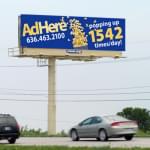How Long Should a Billboard Be Up?
We wanted to share this helpful article posted by AdQuick. Here’s the link to the original article. AdQuick’s mission is to promote out of home as a medium, helping brands benefit from the impact of Outdoor advertising easily.
If you’re considering advertising your brand or business using a billboard, you may have many different questions about how to get the most from your campaign dollars.
It can be confusing trying to decide where the best location for your billboard advertisement is, how much OOH advertising will cost, and of course, trying to answer the question of how long should a billboard be up.
The truth is that the answers to many of these questions will depend in large part on your brand, your campaign goals, and your budget.
We’ll help you break down the answers to your most pressing outdoor advertising questions.
What types of billboards exist?
If you think billboard advertisements are limited to static posters displayed along the sides of highways and interstates, think again.
While traditional out-of-home advertising on billboards still exist and remain popular, there are also several other types of billboards that your brand might be interested in using.
Traditional
Traditional billboards are what most people think of when they hear the word “billboard.”
They consist of a large printed graphic that is transferred onto a large sign, often located along the sides of roadways to target passing motorists.
Traditional billboard spaces cannot be moved to a different location and do not change until the advertising campaign ends.
Digital billboards
Digital billboards represent an exciting evolution in billboard technology.
This type of signage combines the size and staying power of traditional billboards while also incorporating new technology, including graphics that change regularly, interactive technology, and more.
The easiest way to think of digital billboards might be to picture a gigantic television that shows the same image for a set number of seconds before switching to a different image.
Several different companies can advertise on digital billboards at the same time as the image rotates between ads, helping to make them cost-effective.
Wallscapes
You can think of these spectaculars as massive billboard masterpieces.
These incredible advertisements incorporate technology like lighting, video, and interactive mobile technology to reach viewers.
Spectaculars come in many different shapes and sizes depending on their intended purpose and location, but they are usually at least the size of a standard bulletin, if not larger.
What billboard sizes exist?
Although you might think of billboard sizes as all being one and the same, not every billboard is one of the massive signs you see on the side of the interstate.
There are three standard sizes of billboards:
Bulletin
Bulletins are the largest standard size billboards that are available, and they are predominantly found along highways, freeways, interstates, expressways, and other primary arterial roadways.
Bulletins are 14 feet high and 48 feet wide, offering 672 square feet of advertising space.
These billboards target drivers, commuters, and long-distance travelers, and the fact that people pass by them multiple times per day is part of what makes them so effective.
Many people take the same route each day, passing the same advertisements each time.

Posters
Posters offer a smaller size billboard option than bulletins, with the standard size measuring 10 feet high by 22 feet wide, offering 220 square feet of advertising space.
Poster billboards are primarily positioned along primary and secondary arterial roadways, and they’re ideal for targeting local audiences.
Both pedestrians and drivers alike usually see posters, because they are often positioned along roadways that feature crosswalks and sidewalks.
Posters are popular tools for advertising blitzes, where brands post the same advertisement in multiple locations.
Junior posters
Junior posters are smaller than both bulletins and posters, with the standard size measuring 6 feet high by 12 feet wide, offering 72 square feet of advertising space.
You’re most likely to find junior posters in urban neighborhoods or alongside smaller roads where they can target a more local audience.
This type of billboard is best suited for use in close proximity to the business being advertised and can produce quick sales.
Junior posters can effectively reach target audiences that may be difficult to reach outside of their communities, including elderly people who do not travel long distances or ethnic groups that may be concentrated in one area.
How long should a billboard be up?
When it comes to how long a billboard should be up, there is no specific rule.
The answer will vary depending on your marketing campaign goals and your budget. In general, billboard advertisements typically stay up for at least four weeks, but most campaigns last several months.
For example, a business that is looking to run a branding campaign to establish consumer awareness and brand recognition is likely to leave their billboard advertisements up for six to twelve months.
On the other hand, an advertising campaign designed to promote a specific event, sale, or product may be more effective if many billboards are utilized for a shorter period of time, such as a month before the event.
What are the costs of billboard ads?
Compared to forms of advertisement like television commercials and radio, billboard advertisements are extremely cost-effective, and they also have a high return on investment (ROI).
It’s estimated that posters provide eleven times more impressions per dollar than newspapers, eight times more impressions per dollar than television ads, and four times more impressions per dollar than radio ads.
The average cost to reach 1,000 people with a billboard is approximately 3 – 5 dollars, as compared to 7 – 25 dollars with television, 13.50 dollars for radio, 14 – 32 dollars for print, and 10 dollars or more online.
The rate you’ll pay for billboard advertising will depend on the market you’re in, but costs could be as low as 20 dollars per day.

What are the benefits of billboard ads?
Although advertising is constantly changing and there are new ways coming out for brands to market their products each day, billboards remain a popular form of advertising used by large and small companies alike due to the many benefits of billboard advertising.
- Always working: Billboards are like the Energizer bunny – they just keep going and going, and they’re always working. Television or radio ads might only play a few times a day, but billboards are working 24/7.
- Location-specific: Billboard advertising allows brands to choose exactly where they’d like their ad to be placed, which can be a major advantage when trying to draw in local customers or promote a special sale or event.
- Increased brand awareness: One of the biggest advantages of billboards is that they get stuck in your mind because you see the same ones every day. That means that your customers will quickly think of your brand when they have a need for your product or service.
- Minimal effort: Billboards are about the lowest maintenance form of advertising that exists. Just create and post your design and the work is done! Billboards are also extremely effective, with an estimated 71 percent of consumers regularly looking at billboards.
- Increased audience: Billboards increase brand awareness among all age groups, genders, and races, which could potentially increase the audience and reach customers that otherwise would never hear about the product through targeted advertising.
- Unavoidable: People look around at their surroundings as they drive and especially when stopped in traffic, and pedestrians also look ahead as they walk. Billboards provide a captive audience that can’t change the channel or log out.
- Complete control: Advertisers have complete control over their advertisements on billboards, and there are no scheduling changes or conflicts that can occur with your ad. It stays up as long as you pay for it.
- Low cost: The cost of television, radio, and other ads is much higher than that of billboards, which are approximately 80 percent less expensive than television. Billboard advertisements can be purchased for as little as 20 dollars per day, depending on the market.
- Size: Billboards are massive, which makes them nearly impossible to ignore. There are also different size options that make billboards a viable option regardless of whether you need to advertise on the side of the interstate or within an urban area.
- New technology: Billboard advertising doesn’t have to be stale. Digital billboards and spectaculars represent exciting new ways to reach the public with dynamic, interactive content that also enjoys the benefits of traditional billboard advertising.
When should companies consider using billboard advertising?
If you think billboard advertising is only appropriate or affordable for large corporations, think again.
As we’ve established, there is a huge range of size, location, and pricing options for billboards, and the benefits that billboard advertising offers are not only helpful to large companies.
OOH advertising, like billboard campaigns, can help new local brands get established and alert customers to their existence, while large corporations can use billboards to promote brand awareness.
Your advertising media mix should be determined by the audience you’re trying to reach.
There’s no company too large or too small to benefit from outdoor advertising.



